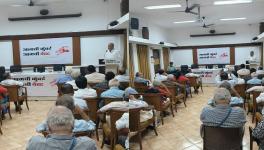Fourth Tranche of FM Sitharaman’s Announcements: Stale Chai in a Worn Out, Leaky Flask

Nirmala Sitharaman and Anurag Thakur. | Image Courtesy: The Hindu
As part of the 20 lakh crore economic package, Finance Minister (FM) Nirmala Sitharaman announced the “fourth tranche” of initiatives taken by the government “under the leadership of PM Narendra Modi,” on May 16. Unlike the previous three “tranches”, the fourth tranche’s announcements did not consist of any loans, loan subventions or loan guarantee schemes. The announcements were all policy decisions about structural reforms in eight sectors namely, Mining, coal, mineral, civil aviation, Defence Production, power, atomic energy and space.
In economics, according to the Keynesian theory, an economic stimulus package, if put in simple terms is, during the time of a recession, the government spending more money to revive a persisting deficit in demand and covering up the shortfall in private consumption and lack of investment. At the time of the global financial crisis of 2007-08, many governments across the world followed this principle.
In India, the economic situation has worsened. The economy has completely stalled due to the unplanned lockdown imposed by the government.
At this stage, the government should have announced big investments in heavy labour intensive infrastructure projects to create more demand, but that exactly is what the government of the day has failed to address till date. Maybe, it is why Modi government did not use the term stimulus package while announcing the measures, which, it believes, will revive the economy.
The key highlights of the fourth tranche announcements were:
-
Commercial Mining introduced in Coal Sector
-
Diversified Opportunities in the Coal Sector
-
Liberalised Regime in the Coal Sector
-
Enhancing Private Investments and Policy Reforms in the Mineral Sector
-
Enhancing Self Reliance in Defence Production
-
Policy Reforms in Defence Production
-
Efficient Airspace Management for Civil Aviation
-
More World-Class Airports through PPP
-
India to become a global hub for Aircraft Maintenance, Repair and Overhaul (MRO)
-
Tariff Policy Reform in Power Sector; Privatization of Distribution in UTs
-
Boosting private sector investment through revamped Viability Gap Funding Scheme in Social Sector
-
Boosting private participation in space activities
-
Reforms in the Atomic Energy Sector
Firstly, Commercial mining in the coal sector was announced as a measure in the 20 lakh crore economic package to address a stalled economy! Under this “reform”, companies from across the world, without prior experience in coal or mining other minerals, can participate in the auction and there will not be any eligibility criteria to participate in the auction.
This announcement actually has nothing to do with the economic package announced by the PM. In fact, parliament passed the Mineral Laws (Amendment) Bill, 2020 in the Budget Session of the Parliament this year (on March 12). What the FM announced was a copy-paste job from the bill.
How can this be a measure of the economic package worth Rs 20-lakh crore?
Diversified Opportunities in the Coal Sector covers Coal Gasification / Liquefaction; Rs 50,000 crore worth infrastructure development in private coal blocks, including Rs 18,000 crore worth of investment in mechanised transfer of coal (conveyor belts) from mines to railway sidings. The Government’s plan for the liquefaction of coal is nothing new. The guidelines for the allocation were issued six years ago, in September 2014.
The online coal projects monitoring portal of the Ministry of Coal mentions 309 accepted infrastructure development works worth thousands of crores, including that of mechanised transfer of coal from mines.
Why is the government claiming the ongoing developmental works are part of a new initiative under the Rs 20 lack crore economic package to revive the economy?
Liberalised Regime in the Coal Sector was another point raised by the FM. The Mining Laws (Amendment) Ordinance, 2020, was promulgated by the President of India on 10 January, 2020. The legislative department of the Ministry of Law and Justice published the ordinance in the Gazette of India on the same day. In the Budget Session of the Parliament in March, the Bill was passed in both Houses and the Mineral Laws (Amendment) Act, 2020 came into force from March 13. The Act intended to liberalise the coal sector. The Amendment allowed participation of multinational companies in coal block auctions and the end use restrictions on the mined coal were removed, along with many other changes.
The Finance Minister did not explain how this became a part of the economic package.
Enhancing Private Investments and Policy Reforms in Mineral Sector was the next point made during the media briefing. Mineral Auction Rules were amended in July 2015 and twice (1st and 2nd amendment) in March this year. The National Mineral Policy, 2008, was changed and a new policy was introduced in 2019. Whatever the FM said the government would do had already been done.
The FM, in her media briefing, said 500 new mining blocks would be opened for auction. The website of Ministry of Mines says, between 2015-16 and 2019-20, the total number of blocks auctioned were just 70 (27 Limestone, 24 Iron Ore, 6 Bauxite, 4 Gold, 3 Graphite, 3 Manganese, 2 Copper and 1 Diamond). It also shows that over 50 years, the Government will earn a total revenue of Rs 2.02 lakh crores from these 70 mines.
If the government could auction only 70 mines in five years, how long it will take for them to auction 500? That is anybody’s guess. And how does this long process for the distant future become a part of the current economic package to revive the economy?
After the Coal and Mineral sectors, the FM spoke about Defence Manufacturing. She said that the Foreign Direct Investment (FDI) limit under the automatic route will be raised from 49% to 74% in the sector. She added that there would be a Project Management Unit (PMU) to support contract management; a Realistic setting of General Staff Qualitative Requirements (GSQRs) of weapons/platforms and overhauling Trial and Testing procedures.
Under the Make In India policy FDI in defence sector was increased to 100% in 2016, though under the automatic route, the cap was increased to 49% from the then existing 26%. Above 49%, the investors have to go through the government route. It was stated back then that the limit is capped at 49% because the sector is concerned with national security and it would not be wise to give foreign companies complete power in defence manufacturing and in joint ventures; the Indian partner should have the controlling stake.
According to the last published DPIIT data (Department for Promotion of Industry and Internal Trade), FDI inflow in to India did not increase much after the policy change in 2016. The FDI inflows for the calendar years 2017, 2018 and between January to September in 2019 were Rs 0.29 million, Rs 156.74 million and Rs 107.35 million respectively. How much investment will come in by increasing the FDI limit to 100% remains to be seen. And, how national security is no longer an issue now is a mystery.
Setting up of a PMU realistic setting of GSQR and overhauling the trial/testing procedures have nothing to do with stalling the economy or reviving it. Even increasing the FDI limit will not bring in any relief to the economy in the near future. Why did the FM announce these yet to be taken steps as a measure to revive the economy is another mystery!
The FM also spoke about the various measures government that the government was planning to introduce in the Civil Aviation Sector. The only major announcement in this segment was the privatisation of the airports controlled by Airport Authority of India (AAI) under a Public Private Partnership (PPP) Model.
In March 2019, NewsClick published a detailed report explaining how the Modi Government violated the law and ignored the advice of some of its own ministries and departments to allow private firms to develop and operate six airports that had been recently upgraded. The changes in the norms enabled the Adani Group, a new entrant in the sector, to win all six bids for developing airports at Ahmedabad, Guwahati, Jaipur, Lucknow, Mangaluru and Thiruvananthapuram. Later, the Government of Kerala and a group of activists in Assam approached the courts against the move and questioned the Government’s motive. Even the Rajasthan Government raised certain concerns. Due to these reasons, only three out of the six airports were handed over to the Adani Group after it won the bid more than a year ago.
A highly placed source in the Ministry of Civil Aviation told this writer and veteran journalist Paranjoy Guha Thakurta that in the second round of auctions, the Government will go by the suggestion put forth by the officials in the PPP meeting and more than two airports will not be awarded to one company or a group in order to avoid further controversies.
When the Delhi and Mumbai airports were privatised nearly 14 years ago, the lease tenure to the concessionaire was 30 years. During the last round, the Modi Government allowed for a 50 year lease tenure. Instead of a revenue sharing model with AAI, the new model is based on a per passenger fee. Various AAI employees’ unions questioned many of the terms of the contracts, alleging that it was framed to benefit private parties and that it would result in losses to the AAI and thus to the Government. They have filed cases in various high courts in different parts of the country and the cases are still ongoing.
In this scenario, how the new set of auctions will proceed is yet to be seen, especially at a time when the economy is in really bad shape and the year-on-year volume of air passengers fell considerably since the last auction.
The move for an Efficient Airspace Management for Civil Aviation which the FM announced was already established a year ago.
As with the earlier announcements, this effort cannot be considered as a part of an economic package to revive the economy at present or in the immediate future.
Whatever FM Nirmala Sitharaman announced for the Power sector were all policy decisions which are not connected to the economic package in any way. The only major announcement related to the sector was the privatisation of Discoms in Union Territories.
The FM also announced Viability Gap Funding (VGF) with a cap of 30% in social infrastructure development projects. Rs 8,100 crore was the mentioned budget for the exercise, which is, again, an old move. In this year’s Budget Speech, the Finance Minister said: “It is proposed to attach a medical college to an existing district hospital in PPP mode. Those states that fully allow the facilities of the hospital to the medical college and wish to provide land at a concession would be able to receive Viability Gap Funding. Details of the scheme would be worked out.”
It has to be remembered now because, during a pandemic, when the public health care system has been left crippled under the pressure of a high number of patients, and when complaints of private hospitals fleecing patients for even simple check-ups, the Modi government, instead of supporting states to invest more in public health care, want to hand over the existing public health care facilities to the private players and is offering VGF to top it as well!
The other occasion when the VGF was mentioned in the budget was when the FM said that the Government would support private players to set up Ayurvedic hospitals in districts where there are no such hospitals available at present.
The next point was about allowing private participation in space programmes and allowing private players to use ISRO facilities for future projects. What has the current economic package got to do with this? The FM did not elaborate.
Reforms in the Atomic Energy Sector: The Finance Minister said that the research reactor shall be established in PPP mode for the production of medical isotopes for the welfare of humanity through affordable treatment for cancer and other diseases.
There is an independent unit called the Board of Radiation & Isotope Technology (BRIT) within the Department of Atomic Energy. Its function is to “provide products and services based on radiation & isotopes for applications in healthcare, agriculture, research and industry.”
When a good government institution already exists, why does the government want to go for a new one using the PPP Model? And how it is related to the economic package?
As mentioned in the beginning of this piece, an economic package to give a stimulus to the economy should have a good amount of immediate spending from the government. The announcements made in this tranche were policy decisions, those about existing projects, a re-announcement of already existing schemes and the Government’s plan to support private entities if they invest money. It is basic economic knowledge that private businesses will not invest capital in a sluggish economy where demand has slowed down.
No one knows how the policy decisions became a part of the Rs 20 lakh crore economic package. In other words, how will these announcements revive the economy when the Government is unwilling to invest?
Ravi Nair is an independent journalist. He can be contacted on Twitter @t_d_h_nair
Get the latest reports & analysis with people's perspective on Protests, movements & deep analytical videos, discussions of the current affairs in your Telegram app. Subscribe to NewsClick's Telegram channel & get Real-Time updates on stories, as they get published on our website.
























